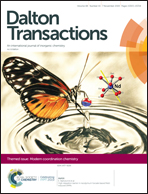Magnetic anisotropy in trigonal planar Fe(ii) bis(trimethylsilyl)amido complexes of the type [Fe{N(SiMe3)2}2L]—experiment and theory†
Abstract
Systematic ac (alternating current) magnetic investigations on four new trigonal planar high-spin Fe2+ complexes [Fe{N(SiMe3)2}2L] reveal that complexes which comprise a phosphine or arsine type ligand (L = PPh3, PMe3 and AsPh3) display slow magnetic relaxation at temperatures below 8 K under applied dc (direct current) fields, whereas a complex with a phosphine oxide ligand (L = OPPh3) does not. Accordingly, the parameters characteristic for magnetic anisotropy, derived both from dc magnetic measurements and quantum chemical calculations, reveal distinct differences for these two types of complexes. Extensive ab initio calculations of multi-reference wave function type were performed on the four new complexes listed above and the related reported ones with L = py, thf and PCy3 in order to get a reasonable description of the local electronic states involved in the magnetic relaxation. These calculations confirm that strong spin–orbit effects generate the magnetic anisotropy of complexes with L = PPh3, PMe3, AsPh3 and PCy3. On the other hand, the complexes with L = OPPh3, py and THF exhibit only small spin–orbit splittings, consistent with the fast relaxation found experimentally.
![Graphical abstract: Magnetic anisotropy in trigonal planar Fe(ii) bis(trimethylsilyl)amido complexes of the type [Fe{N(SiMe3)2}2L]—experiment and theory](/en/Image/Get?imageInfo.ImageType=GA&imageInfo.ImageIdentifier.ManuscriptID=C9DT01702J&imageInfo.ImageIdentifier.Year=2019)
- This article is part of the themed collection: Modern coordination chemistry


 Please wait while we load your content...
Please wait while we load your content...